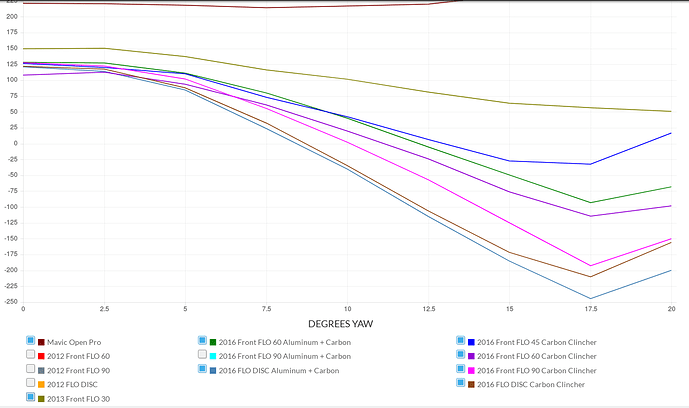A disc acts as a sail in high yaw conditions.
Huh? Hambini has presented quite a bit of data.
90s…would they be Flo?
Yes that is exactly what I am saying. A slow speed will see a higher YAW angle, all else being equal.
I posted this earlier → https://www.dward.us/files/images/flo/TimeSaved2.png
That is a common graph showing the drag of wheels (or even frames) at varying YAW angles. As you can see, the higher the YAW, the less the drag. In fact, once you get to beyond about 8.5 degrees, the aluminium disc creates negative drag, a sail effect. So as the graph illustrates visually, the higher the YAW, the less drag any wheel creates, including a disc and thus, my logic says, the slower you go, the higher the average YAW and thus the greater benefit of a disc wheel (or any deep wheel) when compared to higher speeds.
That’s why I don’t follow ENVE’s logic of a disc only useful over 43kph.
I have never heard of this, actually. I have been hearing that all the blind studies that have been conducted on riders, showed they couldn’t tell which bike or wheel was the more stiff as measured in a lab. From all measurements, the advantage of a stiffer frame or wheel, when expressed as a percentage and rounded to the next whole number, is 0; it is all a placebo.
Exactly.
Not exactly, I went full China on these. They’re 25mm width 88 depth run of the mill u-shape. The factory appears to have good relationships with DT but I’m not positive whether it’s a full on DT knock off. Can report back once they get here.
I think we’d all be interested. Do you do aero field testing (or have a wind tunnel in the backyard)?
Only his original numbers; never anything to further substantiate them.
Field testing applying Chung method, sadly no windtunnel behind the house (that’s where my wife drew the line ![]() )
)
Is there any data on this? Compared to a 90 deep section the disc is covering something like 17% more area, not even counting spoke flange and cassette and the lateral aero resistance of rotating spokes. I’m not disagreeing, I am genuinely curious.
Negative drag = positive force in direction of travel. Not impossible at all.
Yea I know that one, I was curious about data for the sailing hypotheses. No one sails 20 deg into a headwind I think. There shouldn’t be an argument that the disc is faster in predominantly headwindy conditions as shown in the graph. But I’ve never seen data with yaw >90 which is why I asked.
I suggest that you re-visit your free body diagrams. Negative “drag” in the direction of travel for a bicycle wheel is the result of precisely the same physics that allows sailboats to travel upwind (albeit never directly upwind).
ETA: No need to listen to me, of course, but hopefully you will listen to somebody with a PhD in cycling aerodynamics:
" “Sailing a disc”
Some readers may have heard people talk about “sailing” a disk wheel. Whilst this may seem farfetched to those unfamiliar with sailing or aerodynamics, it is in fact a real effect. One key advantage of a disk wheel is that it acts as a wing to the wind. This can result in the resultant aerodynamic load counteracting drag. Much the way that a sail boat is able to move forwards using winds that are not aligned with the direction of travel. However, the trade-off is higher side force than spoked wheels. In this way, under cross wind conditions, a rider is effectively able to “sail” on their disk wheel."
What else would you be looking for other than actual quantifiable test data that challenged CFD model calculations?
I’d argue Flo needs to show actual “data”. But then again, I stopped paying attention to this flap a while ago. Maybe they already have.
“CFD calculations”? Hambini’s claims run counter to direct wind tunnel measurements stretching back decades.
We must be talking about different things then. Cheers.
I think you are misreading that chart…it shows that disc is progressively faster the more yaw you encounter. In a extreme low yaw environment, the benefit of a disc is significantly less.
I don’t know that yaw >90* is even possible…even with a strong tailwind, your forward speed will still create enough drag that the yaw will be <90*
That’s a good idea but I’m not sure it squares with similar performance from a true disk wheel and a covered spoked wheel. Or maybe you’ve discovered that in practice a covered spoked wheel doesn’t work as well as it performs in the wind tunnel? (which would be interesting!)
you mean his extensive wind tunnel test results of multiple wheel combinations? i dont think i have seen him do any CFD
